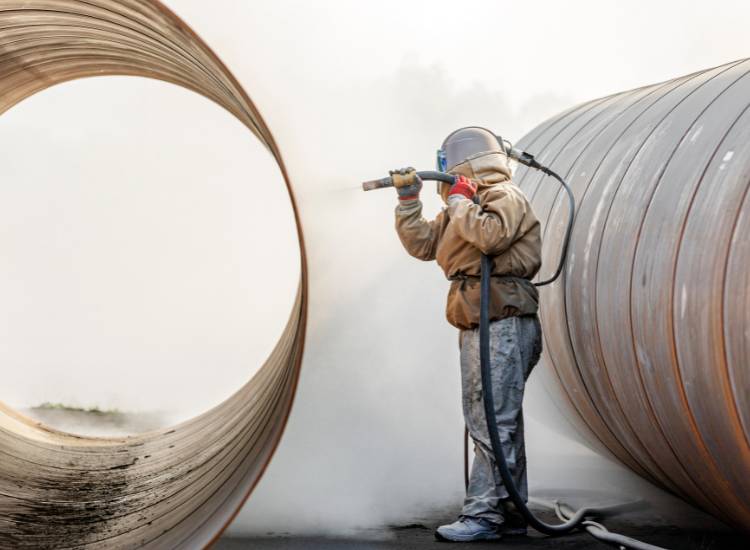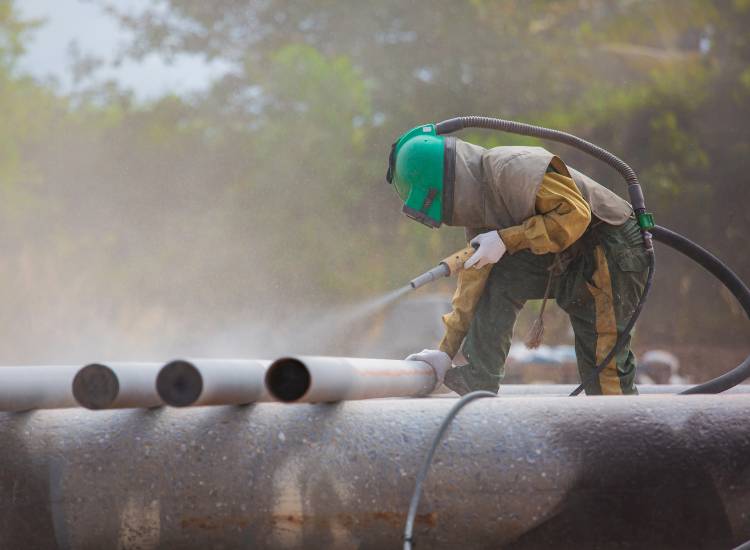What is Media Blasting? (Explained)
Media blasting is a process you might have heard about in various industries. From automotive restoration to cleaning graffiti, this technique offers an effective solution for removing coatings, contaminants, and even rust from surfaces.
Media blasting propels tiny abrasive particles against a surface at high speeds to prepare an area for restoration and refinishing.

By choosing the appropriate media and equipment, you can tackle a range of cleaning and restoration tasks with precision and ease.
Let’s explore into the ins and outs of media blasting in the sections below, to better understand its applications and benefits.
What is Media Blasting?
As we briefly mentioned above, media blasting is a process you can use to clean, strip, or etch surfaces by forcefully projecting abrasive materials. These materials (also known as media) come in various shapes and sizes to match the needs of your specific project.
In media blasting, a high-pressure system is used to shoot media at high velocity against the surface you wish to treat. The type of media and pressure applied can be adjusted depending on the target material, surface, and project.
You can choose from a wide range of abrasives for media blasting. Some common media options include:
- Grit: such as sand, glass beads, or aluminum oxide
- Organic: walnut shells or corncobs
- Plastic: for gentler surface treatments
- Metal: steel shot or cut wire for heavy-duty purposes
It’s essential to consider the surface material and desired result when selecting the appropriate media.
Types of Media Blasting

Sand Blasting
When you think of media blasting, sand blasting might be the first method that comes to mind. It involves the use of sand, pressurized and projected to clean or strip surfaces. Commonly used for removing old paint, rust, and dirt, this method can restore many materials.
However, due to the abrasive nature of sand, it may not be suitable for delicate surfaces. Sand blasting can also create dust, which may cause respiratory issues and environmental concerns.
Bead Blasting
Bead blasting utilizes small glass or ceramic beads as the blasting media, making it less aggressive than sand blasting. This makes it perfect for delicate surfaces that require gentle cleaning. You’ll find bead blasting commonly used on automotive parts, wood, and even glass.
With bead blasting, there’s less risk of damaging the underlying material. Plus, it results in a polished finish, making it suitable for aesthetic purposes.
Soda Blasting
For an eco-friendly option, consider soda blasting. It involves blasting sodium bicarbonate, which is a water-soluble and non-toxic substance. Soda blasting offers a gentle and efficient cleaning process for your projects.
Soda blasting is particularly useful for removing graffiti, mold, and other accumulated dirt on various surfaces. However, since it’s not as aggressive as other methods, it’s crucial to assess if it’s the right choice for your specific task.
The Process of Media Blasting
First, a blasting machine propels abrasive media toward the target surface. The media you choose depends on the specific project and the desired outcome. Common options include sand, glass, and walnut shells.
Before you start, make sure to follow safety guidelines such as wearing protective gear. Remember, selecting the right media and operating pressure is crucial to achieve the desired results without damaging the surface.
Media blasting has multiple applications, such as removing rust, paint, or other surface contaminants. The technique is also useful for prepping surfaces for bonding or coatings.
What are the Advantages of Media Blasting?
- By using different abrasives, media blasting adapts to various materials. It works on delicate and aggressive surfaces, so it’s a great option for most projects.
- Being an eco-friendly choice, media blasting reduces waste. It strips paint or rust, leaving no harmful residue behind.
- Time-saving is another perk. Media blasting quickly propels the abrasives, allowing you to finish your work in a breeze.
- Lastly, uniformity is very helpful when media blasting. The pressure control provides even results to give your surface a polished and professional look.
Media Blasting Equipment
When you start with media blasting, you’ll need some essential equipment. Air compressors are the key, providing the necessary power to blast media particles at high speed. Consider the working pressure (PSI) and air volume (CFM) to ensure effectiveness.
More media blasting equipment includes:
- Blast cabinets let you work in a controlled environment, protecting you and your surroundings from the blast media. These come in various sizes and styles, including siphon and pressure systems.
- Your blast media also plays a crucial role in the process. Options range from abrasive materials like aluminum oxide, glass beads, or steel grit to gentler options like walnut shells and baking soda.
- Protective gear is essential for your safety during the media blasting process. This includes a blasting hood or helmet with a face shield, heavy-duty gloves, and a dust mask or respirator.
- Of course, you’ll need a blast gun and nozzle to direct the media at your target. Various nozzle sizes and shapes are available for different applications.
- Lastly, have an air filtration system in place to maintain clean, dry air during operation. This helps prevent contamination and optimizes your equipment’s performance.
